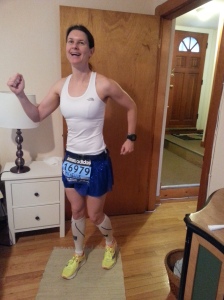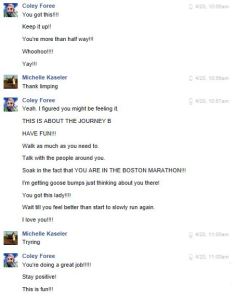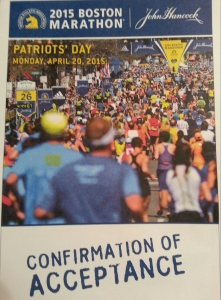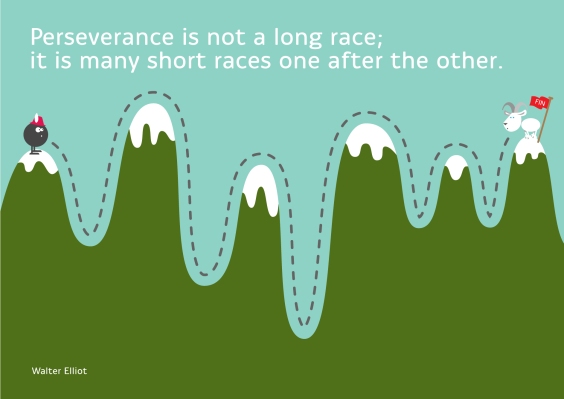Three weeks before the Boston Marathon, I pulled my calf and considered dropping out. I gave it some rest and TLC and decided that run, walk, or hobble, I wanted to experience the legendary race and take home the hardware. Cue Law and Order voice: In Boston Massachusetts, an injured desert dweller tackles 26.2 miles in the rain. This is her story.
At 3 AM Friday morning, my boyfriends’ parents and I drove to Phoenix to catch our flight to Boston. It was 8 PM when we finally reached our Cambridge apartment. We hit packet pickup and the Expo on Saturday. The finish line area had been set up, and runners swarmed the area. I was starting to get excited.
I knew I wanted to buy some of the official clothing, but the line to the fitting rooms was long. Ross’s mom, Sue, tied our jackets together and shielded me while I changed in a corner. A couple of other women liked the idea, and we took turns in the makeshift changing room. A man said, “Hey, if your arms are getting tired, I’ll hold those jackets.” One of the women rolled her eyes, and said, “My husband.” Note: my suitcase gained eleven pounds on the trip.
We explored the city a little bit on Sunday, and were continually amazed with how friendly everyone was. We struck up several conversations with runners and locals on public transit, in restaurants, and simply around town. People were quick to help us find our way around, point out local treasures, and talk about the race.
I had decided on my race outfit a few weeks ago. I’d been having a lot of issues with thigh chafing, whether or not I used Body Glide, so I decided to wear tri shorts for function and a  sparkle skirt for form. I had cheap tube socks for makeshift arm warmers, an ill-fitting long-sleeved cotton shirt, and some cheap knit gloves for throwaway clothes. I fashioned a tank top and skirt out of garbage bags to wear on top of everything else. I gave Ross’s parents my light weather-resistant jacket to hand to me on the course. The rain wasn’t supposed to start until the afternoon, and I get pretty warm once I get moving, so I didn’t want to have it unless I needed it.
sparkle skirt for form. I had cheap tube socks for makeshift arm warmers, an ill-fitting long-sleeved cotton shirt, and some cheap knit gloves for throwaway clothes. I fashioned a tank top and skirt out of garbage bags to wear on top of everything else. I gave Ross’s parents my light weather-resistant jacket to hand to me on the course. The rain wasn’t supposed to start until the afternoon, and I get pretty warm once I get moving, so I didn’t want to have it unless I needed it.
Race morning dawned cloudy and chilly. Unlike most marathons that started around dawn, my wave wasn’t slated to go off until 10:50. I woke up at 7:00 and had yogurt, granola, fruit, and tea at the apartment.
It was a short walk to the Red Line. We got off at the Park exit, and several buses were lined up ready to transport the runners to Hopkinton. The locals waved as we made our way out of town, and I waved back. I had heard about the legendary crowd support in Boston, and had seen it action several times before running a single step. I chatted with a local runner about the Newton Hills and ate a banana and almond butter on the ride. Rain splashed the front windshield.
The Athlete’s Village covered the grounds a local school. Canopies were set up to shelter the athletes, and there were plenty of tables laden with food and water. I grabbed a mini  Clif Bar and headed toward the port-o-pottie lines. The facilities were plentiful, but so were the runners, and the lines moved slowly. I had time, though, so I wasn’t worried. The excitement and nervous energy were palpable. Music was pumping, and a man in dreadlocks grooved along. I felt like hugging him for putting a smile on my face.
Clif Bar and headed toward the port-o-pottie lines. The facilities were plentiful, but so were the runners, and the lines moved slowly. I had time, though, so I wasn’t worried. The excitement and nervous energy were palpable. Music was pumping, and a man in dreadlocks grooved along. I felt like hugging him for putting a smile on my face.
We had to walk .75 miles to reach the starting corrals. Some locals had set up a table and offered Vaseline, hair bands, and a host of other things the racers might need. The throng of bodies provided partial shelter from the wind as the rain misted all around. I was in the first corral of the third wave, and stayed in the back since I wan’t fully healthy. We huddled in the corrals for about ten minutes before we were sent off with the blast (and I do mean blast!) of the gun.
Everyone was corralled according to qualifying times, so the large group moved smoothly. I set off at what felt like an easy pace. The early miles were downhill, and I had been warned to hold back. When I checked my pace and saw mid-eight, I wasn’t sure if I should worry. I felt like it would take more of an effort to slow myself down than to go with the flow. I would run by feel, and I certainly wasn’t pushing.
I had a new, larger handheld bottle with shot bloks and a sunscreen stick tucked into the pouch for quick access. My biceps burned, so I kept switching it back and forth between hands. I felt each extra ounce. Shame on me for not trying it out before race day.
While I was still surrounded by runners, brightly-colored bobbing heads stretched out as far as my eye could see. I knocked off a couple more mid-eightish miles and started to think that the sub-4 hour finish was still a possibility. From time to time, male runners stepped off the course and turned their backs. The song “Whip It” popped into my head. Hydration tables were set up on the right side of the course and then the left, so the runners never had to move too far to reach them. I drank some Gatorade.
After four miles, my injured calf tightened up. I hoped it was just a reaction to the cold weather and would work itself out. Five miles in, tightness turned to pain, and I decided to walk up the next hill. When I started running again, the pain returned. My body was warm by now, and I tossed the garbage bag top. By mile six, the pain had intensified to the point that I knew I had to walk.
Ross’s parents were waiting at the 10K point and they asked me if I wanted my jacket. I was still fairly warm and said no. I told them that I was hurt and would probably be walking a lot. The course would be shut down six hours after the start of the fourth wave. The first six miles were faster than I had planned, but I still had twenty to go. The world record for race walking a marathon was 3:21:54. Time to see what I could do.
The next four miles went by fairly quickly as I was able to hold about a twelve-minute mile pace. Still, it was hard not to get discouraged as hordes of healthy runners flew by. Even though the weather was bad, the course was still lined with spectators who cheered, waved signs, and passed out water and food. There is no need to carry water at Boston.
As I approached Wellesley, I wanted to see if I could pick it up. Bad idea. A stabbing pain shot through my calf, and I was forced to slow down. My right hip flexor was also in agony because it was not used to prolonged bouts of speed walking. I lost it at this point and started bawling. My ragged, gulping sobs were lost in the cacophony. I felt alone and defeated. Every time I heard someone say, “You look great!” I knew they weren’t talking about me. I tried to focus on the beautiful trees and lakes and the Wellesley girls that were waving signs asking for kisses.
I was walking so slowly now that I wasn’t generating much body heat and a chill set in. My legs were in a lot of pain and my pace had slowed to twenty-plus minutes a mile. Far slower than what I needed to make the cutoff. Ross’s parents were supposed to be at the halfway point, and I decided that I’d quit when I saw them. There was so much race left, and I didn’t want to risk being injured for months. I thought about the special Boston Marathon medal display hook that Sue had given me hanging empty, judging me.
Mile 13 came and went with no sign of my support crew. I texted them. Nothing (I later learned they were having their own adventures with inconsistent trains and spotty cell service). All I wanted was to find them so I could get off of my feet and into warm, dry clothes. I texted Ross and Facebook-messaged his sister. As you can see, cold fingers do not type well.

Ross called. I don’t remember what exactly what he said, but it was great to hear his voice. He encouraged me and said he’d keep trying his parents. My phone, which had been fully charged a few hours ago, was down to 37%, so I said goodbye and switched to airplane mode.
The rain let up a bit, and the slower pace eased my hip flexor pain, so I hobbled on. I thought about my friend Susie, whose twisted spine eventually caused her to hang up her sneakers. I thought about her husband Jon, who had finished an Ironman after being diagnosed with the ALS that eventually took his life. Limping or not, I was doing something they couldn’t. I’d like to say those thoughts immediately strengthened my resolve, but they were just a few of many that ping-ponged around my head.
I didn’t feel the part, but I said aloud, “I am a runner. I am a runner.”
At mile 17, I encountered the famous Newton Hills, which caused searing pain in my calf. I turned the toe of my injured leg at a 90-degree angle, and walk-sidled up the hills. One of the hills was so steep that I thought it had to be Heartbreak, which meant the course would soon flatten out again, but the hills kept on coming. By now, I was mixed in with the run/walkers and the occasional blind runner and guide.
A med tent worker asked if I needed help. When I said I had a calf pull, she told me to go inside. I laid face down on the padded table while a medic massaged my muscle. When she asked if it helped, I said yes. Being off it certainly felt better, but I wasn’t sure how much the massage would help once I started again. No matter. I had a race to finish.
Due to my side-walking, I got a good look at the spectators. I had written my name on my bib, and some people cheered for me personally. I made eye contact with a couple of guys who yelled, “Yeah, Michelle! You’re doing great. You’re awesome!” Something about their energy combined with those New England accents made me start crying. Again. They cheered louder.
I’d been on the course long enough to crave something more substantial than Gatorade and energy chews. A man and his daughter held out a box of cookies. Normally I’d pass because I’d be afraid they wouldn’t digest well, but at my pace, it was a non-issue. I savored the sweet, chocolate-peanuty crunchiness. I took a slice of watermelon from another spectator. Oranges, red licorice, and Swedish Fish were other popular offerings – the Boston Marathon was like a long trick-or-treating session with moisture-wicking costumes.
Since going uphill caused the most strain, I figured the reverse had to be true for the downhills, so I tried running the next one. I remembered reading that sometimes calf problems occur because the legs are too straight, so I adopted a semi-crouched position.
It worked.
I couldn’t reach the speeds I had been hitting at the beginning of the race, but it was an improvement. I felt like Forrest Gump after his leg braces fell off. I could almost hear Tom Hanks say, “I… was… running!”
After mile 20, things flattened out, and I realized I only had 10K to go. I can do this. I walked whenever the road sloped up, but I was on track to finish in less than six hours.
During one of my walk breaks, I saw the dancing dreadlocked man from the Athlete’s Village. His name was Eli and he was from Atlanta.
“I wanted to finish under 3:30, but after mile six everything hurt,” he said, drawing out the eh sound in everything.
“But we’re doing it, we’re going to finish!”
“Yes we are! We ain’t stopping.”
“We’re getting those medals. Tough it out, baby!”
“I tell you, eeeeeeverything hurts, but you’re inspiring me to walk faster.”
“We’ll help each other through. We’ve got this!”
We hung together for about a mile when he told me to go ahead and he’d catch up. Ten minutes later he passed me, looking strong. I didn’t see him again, but I was grateful for the short connection we’s shared.
The rain had started up again, and I sloshed through the cold puddles. Several competitors were wearing plastic rain ponchos and I wished I hadn’t tossed my trash bags. I was still wearing all of the clothes I had planned to throw away, so my crappy cotton shirt would survive to see the beginning of another race. My right toes hurt from slamming into the front of my shoes on so many downhills.
Despite the worsening weather and the fact that it had been over six hours since the elite women had toed the line, several spectators still lined the course. A couple of girls jumped up and down and called my name. The the crowd started chanting “Left on Hereford, right on Boylston,” and I knew my journey was almost complete. Some people banged on drums, and I focused on the pounding rhythm.
Boylston. Finally. There was still over a quarter mile to go, but I could see the finish line. I squat-ran as fast as I could until I passed that final timing mat. My body shook with tears. I’d made it.
Mission accomplished, my brain decided to stop pumping out adrenaline or whatever it had been giving me the last several hours. My raw, aching legs inched along. Since I was no longer exerting myself, I cooled rapidly. There was still a way to walk before I got my medal. A kind volunteer gave me a disposable poncho and tied a mylar blanket around my waist.
More walking. I shivered violently and a volunteer asked if I needed help. “Just show me where to find K in family meeting area.”
She pointed down the road and said, “They’re letting people warm up by sitting in the buses.” Since the bus was much closer than the K, I decided to hobble over.
A few runners were coming out of the bus and the driver said, “You can’t sit here anymore. Warm up in the med tent.”
Our little group walked to the med tent where we were told, “This is for medical treatment. It’s not a warming tent. Go sit in the buses.”
I made my to different a different bus, but got the same story: go to the med tent. At this point, I thought screw it, and headed toward the K area.
A wide-eyed volunteer stopped me and had me sit in a wheelchair while another volunteer gave me some coffee. My hands shook and hot liquid sloshed over the side of the cup and seeped into my already wet gloves. I had gone from a Boston Qualifying runner to quivering invalid in the space of six hours. They pushed me to the K sign, and I saw the Forees. They supported me on the slow walk/subway/walk back the apartment. As I relaxed into a hot bath and sipped a steaming cup of tea, I got a glimpse of heaven on earth.
Garmin data: https://connect.garmin.com/modern/activity/756961394
If you’d like to read about more Boston experiences and see some on-course pictures, check out The Half Ass Bad Ass, Blessed With Thunder Thighs, and Runs On Syrup.
As tough as my race was, it was nothing compared to what this man endured. http://boston.cbslocal.com/2015/04/21/boston-marathons-final-finisher-an-inspirational-story/













